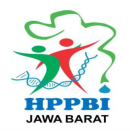Antibacterial Potential of West Kalimantan Local Bajakah (Spatholobus suberectus) Ethanol Extract against Micrococcus luteus
DOI:
https://doi.org/10.25134/quagga.v15i2.27Keywords:
Antibacterial, Anti-dandruff, Bajakah, Spatolobus suberectus, Micrococcus luteusAbstract
Bajakah Jie Xue Teng (Spatholobus suberectus) is an endemic plant from West Kalimantan which is the potential as a natural antimicrobial, but its antimicrobial ability has not been widely reported so that it can be tested on Micrococcus luteus bacteria which is the agent causing dandruff. The purpose of this study is to describe the phytochemical content of Jie Xue Teng (Spatholobus suberectus) bajakah ethanol extract and its potential to inhibit M. luteus in vitro. The phytochemical content of the extract was tested using the Thin Layer Chromatography (TLC) method. The type of research is a laboratory experiment using the Kirby Baeur disk diffusion method with swab technique with a series of extract concentrations of 1000 mg/ml, 500 mg/ml, 250 mg/ml, and 125 mg/ml, positive control (30% amoxilin), and negative control (DMSO 10%) with 4 repetitions. The phytochemical content of the ethanol extract of bajakah that was tested shows secondary metabolites of steroids, flavonoids, saponins, and alkaloids. Bajakah ethanol extract has the inhibitory potential against M. luteus for all test concentrations which fall under the moderate category. The diameter of the amoxicillin inhibition zone was still larger than the extract inhibition zone.
References
Abdulrahman, Utami, S., Widia, & Roanisca, O. (2021). Kajian Metabolit Sekunder Batang Bajakah (Spatholobus Littoralis Hassk.) Dalam Pengembangan Sebagai Obat Herbal Antikanker Payudara dan Antioksidan. Seminar Nasional Penelitian Dan Pengabdian Masyarakat, 5, 46–49.
Akhavan, B., Khanna, N., & Vijhani, P. (2022). Amoxicillin. StatPearls Publishing LLC.
Amiani, W., Ricko Fahrizal, M., & Nathasya Aprelea, R. (2022). Kandungan Metabolit Sekunder dan Aktivitas Tanaman Bajakah Sebagai Agen Antioksidan. Jurnal Health Sains, 3(4), 516–522. https://doi.org/10.46799/jhs.v3i4.461
Bernatova, S., Samek, O., Pilat, Z., Sery, M., Jezek, J., Jakl, P., & Siler, M. (2013). Following the Mechanisms of Bacteriostatic versus Bactericidal Action Using Raman Spectroscopy. Molecules, 18(11), 13188–13199.
Borges, A., Ferreira, C., Saavedra, M., & Simoes, M. (2013). Antibacterial Activity and Mode of Action of Ferulic and Gallic Acids Against Pathogenic Bacteria. Microb Drug Resist, 19(4), 256–265.
Byrd, A., Belkaid, Y., & Segre, J. (2018). The Human Skin Microbiome. National Center for Biotechnology Information, 16(3), 143–155.
Cavalieri, S., Rankin, R., Harbeck, R., Sautter, Y., McCarter, S., Sharp, J., & Ortez, S. (2005). Manual of Antimicrobial Susceptibility Testing. American Society for Microbiology.
Cho, H., Chung, B., Kim, C.-K., Oh, D.-C., Oh, K.-B., & Shin, J. (2017). Spatholobus suberectus Dunn. constituents inhibit sortase A and Staphylococcus aureus cell clumping to fibrinogen. Arch Pharm Res, 40(4), 518–523.
Dogan, A., Otlu, S., Çelebi, özgür, Kiliçle, P. A., Saglam, A. G., Can Dogan, A. N., & Mutlu, N. (2017). An investigation of antibacterial effects of steroids. Turkish Journal of Veterinary and Animal Sciences, 41(2), 302–305. https://doi.org/10.3906/vet-1510-24
Echeverria, J., Opazo, J., Mendoza, L., Urzua, A., & Wilkens, M. (2017). Structure-Activity and Lipophilicity Relationships of Selected Antibacterial Natural Flavones and Flavanones of Chilean Flora. Molecules, 22(4), 608.
Fachriyah, E., Wibawa, P. J., & Awaliyah, A. (2020). Antibacterial activity of basil oil (Ocimum basilicum L) and basil oil nanoemulsion. Journal of Physics: Conference Series, 1524(1). https://doi.org/10.1088/1742-6596/1524/1/012060
Fitriani, F., Sampepena, E., & Saputra, S. (2020). Karakterisasi Tumbuhan Akar Bajakah (Spatholobus littoralis Hassk.) . Jurnal Riset Teknologi Industri, 14(2), 365.
Flores-Sanchez, I. J., & Ramos-Valdivia, A. C. (2017). A Review from Patents Inspired by Two Plant Genera: Uncaria and Hamelia. Phytochemistry Reviews, 16(4), 693–723.
Galvao, J., Davis, B., Tilley, M., Normando, E., Duchen, M., & Cordeiro. (2014). Unexpected low-dose toxicity of the universal solvent DMSO. National Center for Biotechnology Information, 28(3), 1–14.
Glauert, A., Dingle, J., & Lucy, J. (1962). Action of Saponin on Biological Cell Membranes. Nature, 196, 953–955.
Grimshaw, S., Smith, A., Arnold, D., Xu, E., Hoptroff, M., & Murphy, B. (2019). The Diversity and Abundance of Fungi and Bacteria on The Healthy and Dandruff Affected Human Scalp. PlosOne, 14(12).
Hoover, E., Aslam, S., & Krishnamurthy, K. (2022). Physiology, Sebaceous Glands. StatPearls Publishing.
Iskandar, D., & Warsidah, W. (2020). Qualitative Phytochemical Screening and Antioxidant Activity of Ethanol Root Extract of Spatholobus littoralis Hassk. The Journal of Food and Medicinal Plants, 1(1), 13–15. https://doi.org/10.25077/jfmp.1.1.13-15.2020
Jacobsen, N. (1985). The Cryptocoryne (Araceae) of Borneo. Nordic Journal of Botany, 5(1), 31–50.
Kaur, S., Rao, R., & Nanda, S. (2011). Amoxicillin: a Broad Spectrum Antibiotic. International Journal of Pharmacy and Pharmaceutical Science, 3(3), 30–37.
Kloos, W. E., & Musslewhite, M. S. (1975). Distribution and Persistence of Staphylococcus And Micrococcus Species and Other Aerobic Bacteria on Human Skin. Appl Microbiol, 30(3), 381–385.
Kurniawan, B. (2019). Uji Aktivitas Antibakteri Batang Bajakah Tampala (Spatholobus Littoralis Hassk.) Terhadap Bakteri Staphylococcus Aureus ATCC 26923. Pharmacy: Jurnal Farmasi Indonesia, 16(2), 178–193.
Liu, J., Du, C., Beaman, H., & Monroe, M. (2020). Characterization of Phenolic Acid Antimicrobial and Antioxidant Structure–Property Relationships. Pharmaceutics, 12(5), 419.
Mabhiza, D., Chitemerere, T., & Mukanganyama, S. (2016). Antibacterial Properties of Alkaloid Extracts From Callistemon Citrinus and Vernonia Adoensis Against Staphylococcus Aureus and Pseudomonas Aeruginosa. International Journal of Medicinal Chemistry, 2016, 1–7. https://doi.org/10.1155/2016/6304163
Madigan, M. (2012). Brock Biology of Microorganism. Prentice Hall Inc.
Maulidie, M., Saputera, A., Widia, T., Marpaung, A., Ayuchecaria, N., Farmasi, A., & Banjarmasin, I. (2019). Konsentrasi Hambat Minimum (KHM) Kadar Ekstrak Etanol Batang Bajakah Tampala (Spatholobus littoralis Hassk) Terhadap Bakteri Escherichia coli Melalui Metode Sumuran, 5 (2).
Maulina, S., Pratiwi, D., & Erwin. (2019). Skrining Fitokimia dan Bioaktivitas Ekstrak Akar Uncaria nervosa Elmer (Bajakah). Jurnal Atomik, 4(2), 100–102.
Nagaralli, B., Jaldappagari, S., & Melwanki, M. (2002). Sensitive Spectrophotometric Methods For The Determination of Amoxycillin, Ciprofloxacin and Piroxicam in Pure and Pharmaceutical Formulations. Journal of Pharmaceutical and Biomedical Analysis, 29(5), 859–864.
Nuria, M., Faizatun, A., & Sumantri. (2009). Uji Aktivitas Antibakteri Ekstrak Etanol Daun Jarak Pagar (Jatropha curcas L.) terhadap bakteri Staphylococcus aureus ATCC 2593, Eschericia coli ATCC 25922, dan Salmonella Thyphii ATCC 1408. Mediagro, 5(2), 26–37.
Osonga, F. J., Akgul, A., Miller, R. M., Eshun, G. B., Yazgan, I., Akgul, A., & Sadik, O. A. (2019). Antimicrobial Activity of a New Class of Phosphorylated and Modified Flavonoids. ACS Omega, 4(7), 12865–12871. https://doi.org/10.1021/acsomega.9b00077
Othman, L., Sleiman, A., & Massih, R. (2019). Antimicrobial Activity of Polyphenols and Alkaloids in Middle Eastern Plants. Front Microbiol, 10, 911.
Park, W., Ahn, C.-H., Cho, H., Kim, C.-K., Shin, J., & Oh, K.-B. (2017). Inhibitory Effects of Flavonoids from Spatholobus suberectus on Sortase A and Sortase A-Mediated Aggregation of Streptococcus mutans. Journal Microbiol Biotechnol, 27(8), 1457–1460.
Rajput, R. (2017). Role of Non Androgenic Factors in Hair loss and Hair Regrowth. Journal of Cosmetology & Trichology, 3(2).
Ravipati, A. S., Reddy, N., & Koyyalamudi, S. R. (2014). Biologically active compounds from the genus Uncaria (Rubiaceae). In Studies in Natural Products Chemistry. 43. https://doi.org/10.1016/B978-0-444-63430-6.00013-8
Sims, G. K., & Sommers, L. E. (1986). Biodegradation of Pyridine Derivatives in Soil Suspensions. Environmental Toxicology and Chemistry, 5(6), 503–509.
Siska, B., Snejdrova, E., Machac, I., Dolecek, P., & Martiska, J. (2019). Contribution to The Rheological Testing of Pharmaceutical Semisolids. Pharmaceutical Development and Technology , 24(1), 80–88.
Suwandi, J. (2009). Pengaruh Pemberian DMSO Sebagai Pelarut Bahan Uji Pada Uji Aktivitas Antiplasmodium Invivo Terhadap Pertumbuhan Plasmodium Berghei Pada Mencit. Jurnal Sains Matematika Dan Ilmu Pengetahuan Alam, 15(3), 207–210.
Sweetman, S. (2009). Martindale: The Complete Drug Reference (Thirty-sixth Edition). Pharmaceutical Press.
Tang, R.-N., Qu, X.-B., Guan, S.-H., & Xu, P. (2012). Chemical Constituents of Spatholobus suberectus. Chinese Journal of Natural Medicines, 10(1), 32–50.
Vida, N., Svobodova, H., Rarova, L., Drasar, P., Saman, D., Cvacka, J., & Wimmer, Z. (2012). Polyamine conjugates of stigmasterol. Steroids, 77(12), 1212–1218.
Xu, H., Song, J., Luo, H., Zhang, Y., Li, Q., Zhu, Y., Xu, J., Li, Y., Song, C., Wang, B., Sun, W., Shen, G., Zhang, X., Qian, J., Ji, A., Xu, Z., Luo, X., He, L., Li, C., … Chen, S. (2016). Analysis of the Genome Sequence of the Medicinal Plant Salvia miltiorrhiza. In Molecular Plant, 9 (6), 949–952. Cell Press. https://doi.org/10.1016/j.molp.2016.03.010
Zhang, Q. , Z. J. J. , X. J. , Feng. F. dan Q. W. (2015). Medicinal Uses, Phytochemistry and Pharmacology of The Genus Uncaria. Journal of Enthopharmacology, 173, 48–80.




















